Explore Death Valley and beyond with the ultimate desert road trip guide—travel from the glitz of Vegas to the desolate beauty of the desert. This three day itinerary showcases the best this famous National Park has to offer.
The Ultimate 3-Day Death Valley Road Trip Itinerary
Every year, millions of people visit Nevada to check out Las Vegas. But Nevada has so much more to offer than just casinos, bright lights, and Las Vegas shenanigans. In fact, the state features some of the best national parks in the country.
If you’ve never visited Death Valley National Park, it can be hard to believe such a desolate place can be this beautiful. It’s an otherworldly part of the United States. It’s like you’ve left Earth and visited a new world—something I’ve only experienced in places like Jordan and Iceland!
Which is why it’s no surprise that this place is loved by photographers, hikers, and nature lovers all over the world.

Now look, you can easily see Death Valley with a quick day trip from Las Vegas, but that isn’t going to do it justice. If you want the full Death Valley experience, you’re going to want to do the full Death Drive and head out on a multi-day road trip.
A full loop of the park with enough time to see all the major sites takes a few days and includes around 365 miles of driving.
Click here for a Google Map of the full route, which took me three full days to complete, capturing every sunrise and sunset along the way.
Whether you’re looking to photograph the scenery, hike to the Ubehebe Crater, or explore the Mesquite Flat Sand Dunes, this place really does have a lot to offer.
Where is Death Valley National Park?
Death Valley National Park sits on the border between California and the southern corner of Nevada. The valley runs north to south and is approximately 140 miles long. The nearest major city is Las Vegas, Nevada.
The drive from Las Vegas to the entrance of Death Valley only takes around 2 hours, one way, making this a great option for a quick road trip, or an extended visit.
The Best Time to Visit Death Valley: Death Valley National Park Weather
If you want to beat the heat, the best time to visit Death Valley is between October and May. While the winter season is a slow period for most national parks, that’s when Death Valley National Park really starts to come back to life.
During this time, high daytime temperatures in the park range from 100°F, all the way down to the mid-60s.
But if you visit between April to October, expect temperatures above 100°F (37°C). It typically has record-setting temperatures every summer and a world record high air temperature of 134°F (57°C).
In fact, Death Valley holds the record for the driest, hottest, and lowest national park in the country.
If the idea of cooking an egg on the hood of your car isn’t your thing, you’ll want to plan your visit around these temperatures.
Click here for an up-to-date weather forecast of Death Valley.
Death Valley Elevation: The Lowest Point in North America
Besides being known for record setting high temperatures, Badwater Basin in Death Valley is also known as the lowest point in all of North America.
Feel free to use that one on trivia night.
Just 18 miles from the park’s Furnace Creek Visitor Center you’ll find Badwater Basin. It’s not only the lowest point in the park, but the lowest point in North America! It’s a full 282 feet (86 m) below sea level. For contrast, the lowest place on Earth is the Dead Sea in Israel/Jordan/Palestine, weighing in at a whopping 1,391 feet (424 m) below sea level.

Why is it Called Death Valley?
Don’t let the “death” in Death Valley fool you—this region is full of life. If you look close enough, you may see small reptiles, wildflowers, birds, and coyotes.
The name Death Valley comes from a group of pioneers who crossed the desert in the winter of 1849-1850. I can’t help but feel bad for these first settlers who were looking to expand the American frontier even further west. The region can be harsh if you aren’t prepared for it…and they weren’t.
As far as we know, only one member of the pioneer group died that winter, but the harsh conditions led the group to assume they, too, would perish here.
That original group became lost and spent more time in Death Valley than they originally wanted to. They finally escaped the valley after two young members of their group learned to scout. The party finally managed to reach the mountains and were able to escape the valley.
And as the legend goes, one of those pioneers turned around, looked back to the desert, and declared, “Goodbye, Death Valley!”
The story became a legend, and the name stuck.
Death Valley National Park Map
When visiting Death Valley, you’re going to want a map. While the park has many paved roads and marked trails, it also has plenty of rougher gravel roads and more remote hiking options. Even if you’re prepared, you want to respect the harsh climate that Death Valley is known for. You never want to get lost, or run out of water while visiting.
Luckily, the Death Valley National Park Service has several helpful maps which you can find on their website. You can also use the interactive map below:
Getting from Las Vegas to Death Valley
The closest major city to Death Valley National Park is Las Vegas which means, if you’re flying in from out of town, the LAS airport is going to be your destination.
Before leaving Vegas, make sure to stock up on supplies. While there are many small towns between Las Vegas and Death Valley, you don’t want to take a chance. There are plenty of supermarkets and even a Whole Foods right down the street from the airport.
Even if you’re coming to Death Valley for a quick visit, make sure to bring enough water, sunscreen, food, and any other essentials. Sunglasses and a hat are must-haves.
It’s a two hour drive from the Las Vegas strip to the entrance of Death Valley. All-in-all, the trip is around 110 miles.
- Leaving Vegas in the afternoon, you’ll want to head West on NV-160 towards Pahrump, a small town known as the gateway into Death Valley. The drive to Pahrump takes just over an hour. I recommend staying here for the night before heading into the National Park in the morning for your first full day.
- For food options between Vegas and Pahrump, I recommend a stop at Mountain Springs Saloon near Spring Mountain. The saloon has a special pig roast every Saturday from March through October.
- If you’d rather wait until you get to Pahrump, I suggest dinner at Symphony’s Restaurant located in the Pahrump Valley Winery.
- The next day, leaving Pahrump, head West on CA-190 towards the Furnace Creek Visitors Center. You’ll enter Death Valley in just under an hour, and the full drive to the visitors center shouldn’t take more than another 20 minutes. That makes for a total journey of 60.5 miles and takes around 1 hour and 10 minutes.
For any photographers reading, make sure you get an early start the next morning to catch the famous Death Valley sunrise.
Best Things to Do and See in Death Valley
Day One:
It’s day one, you’re still fresh, and you aren’t even thinking about the sunburn yet. The first day is all about taking in the natural beauty of Death Valley. You’re going to check out the Badwater Basin, the Artist’s Palette, and Zabriskie Point.
The best part? You’re going to see distinct features like the lowest point in North America, vivid desert colors, and a breathtaking view to top it all off.
Badwater Basin
After entering the park and stopping by the Furnace Creek Visitor Center, head towards Badwater Basin. Here you will find the lowest, hottest, and driest place in North America: Badwater Basin. The drive out to the Basin is called Badwater Road, and it is one of the most popular drives in the park.
Artist’s Palette

Next, be sure to check out Artist’s Drive. It’s a byway off Badwater Road.
This roughly nine-mile road takes you through some of the most amazing scenery in the park. The best part comes just five miles in where unique colors splash a group of mountains and canyons, resembling—you guessed it—an artist’s palette.
Zabriskie Point

For sunset, you won’t want to miss Zabriskie Point. It’s a short 15-minute drive back past the visitor’s center. After parking your car, take a short walk up the hill to the summit and watch the sunset over the vastness of the desert.
Trust me. You’ll be happy the sun is setting after a long day in the heat.
Overnight
Death Valley National Park has a number of camping options with a few convenient campgrounds located around the Furnace Creek Visitor Center. You can also opt for a stay at the Furnace Creek Inn or the Furnace Creek Ranch, both of which are located in the park.
You can also stay overnight at this classic inn in Beatty, a small town just outside the National Park. Another town considered to be a gateway to Death Valley, stop here for a true taste of local Nevada.
If you’re looking for a little adventure, I suggest you try camping out in the desert. It’s something everyone should try at least once.
Day Two:
Hopefully, you got an early night’s sleep and are ready to go. Depending on where you stayed last night, your second day could look quite different than mine. From Beatty, our first stop was the Rhyolite Ghost Town, but if you stayed inside the park, you might end up doing things in reverse.
Mesquite Flat Sand Dunes
Get an early start and head north from Furnace Creek towards the Mesquite Flat Sand Dunes. While Death Valley has several sand dunes, these are easily the most accessible.
If hiking in the dunes, make sure to bring appropriate shoes and be ready for a workout. Sand may seem light from a distance, but just wait until you’re sinking in it with every step you take. Bonus points if you hum the theme song to Lawrence of Arabia.
Note: If you’re a photographer, the Mesquite Flat Sand Dunes have better lighting at sunset. It might throw a bit of a wrench in your itinerary, but I’d recommend catching the Dunes for sunset on Day One and Zabriskie Point for sunrise on Day Two.
Racetrack Playa
Drive a little bit further north, and you’ll find the Racetrack Playa. It’s located 27 miles down a dirt road, so expect the driving to take a little longer than normal.
You’ll want a 4WD vehicle and a few extra hours for the trip. It’s actually the perfect opportunity to escape the heat of the midday sun. Just crank up the A/C, blast some road-trip tunes, and spend a few hours driving.
Racetrack Playa, a remote, dry lake bed is best known for the mysterious rocks that seem to have glided by themselves across the desert floor. The natural phenomenon is the source of scientific research and conspiracy theories alike.
Rhyolite Ghost Town

After another full day in Death Valley National Park, head East towards Rhyolite, a ghost town located just outside the park limits. Once a booming mining town, Rhyolite is one of the most photographed ghost towns in this part of the country. Most of the wood structures have been relocated, but you can still see the remains of the old bank, brothel, and jail. It’s clear this town had its priorities in mind.
Overnight
By the end of the day you’re going to be exhausted. To prepare yourself for day three, I suggest an overnight in Mount Charleston at the Retreat on Charleston Peak (formerly the Resort at Mount Charleston).
Day Three:
Hopefully you don’t hate the heat by now. But if you do, you’re going to like day three. Why? Two words, Mt. Charleston. Unlike the rest of Death Valley, Mt. Charleston is nearly 20-30° than many of the other areas you visited.
And to top it all off, you can visit the Valley of Fire on your way back to Las Vegas. This is a place that’s worth checking out. Trust me.
Mt. Charleston
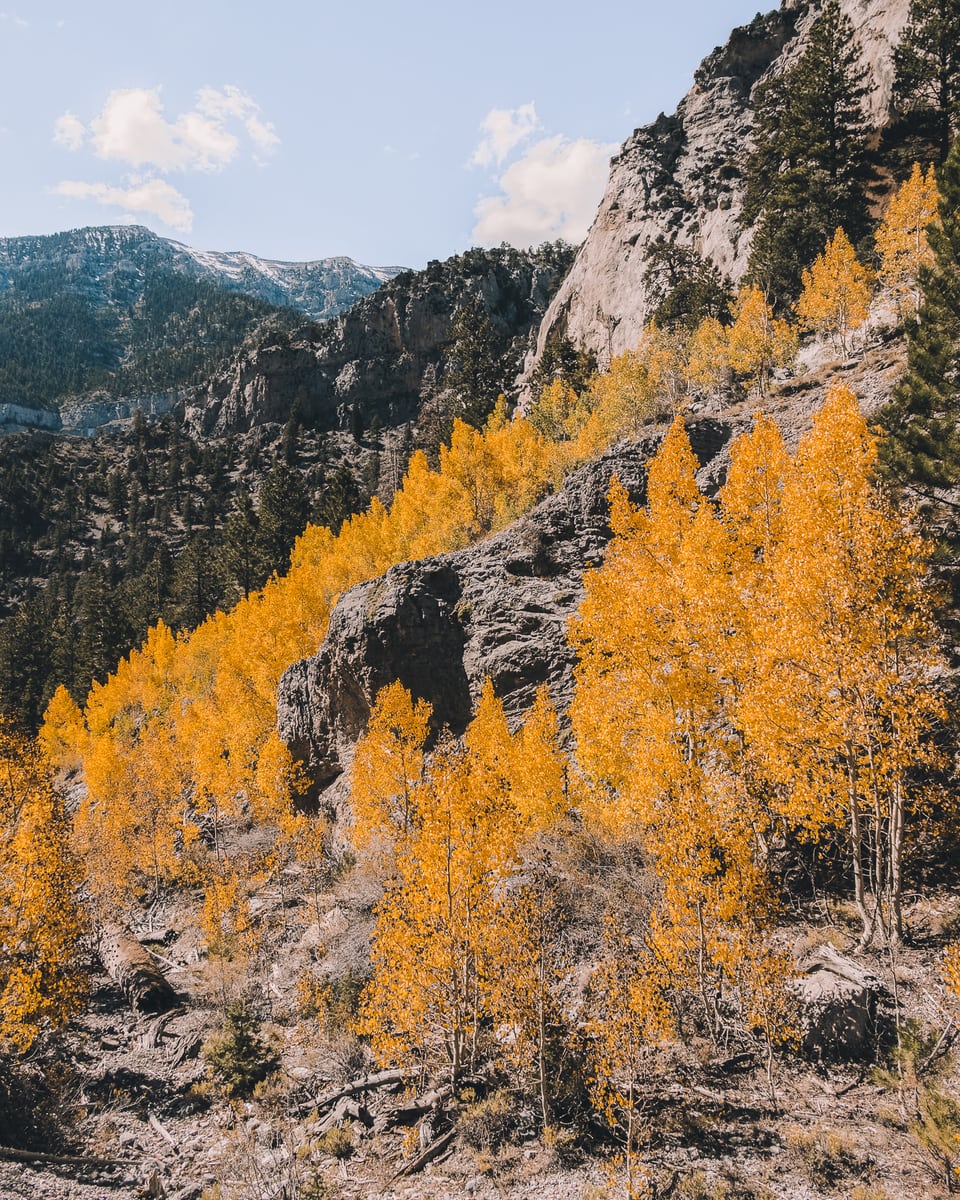
Rising from the desert, Mt. Charleston is one of Nevada’s highest peaks and the perfect place to explore after a few days in Death Valley.
Good news! Unlike the other areas you’ve been, Mt. Charleston is around 20-30° cooler than the desert below. I recommend you pack a light windbreaker, or a heavier jacket if you are visiting mid-winter.
Bonus: Valley of Fire
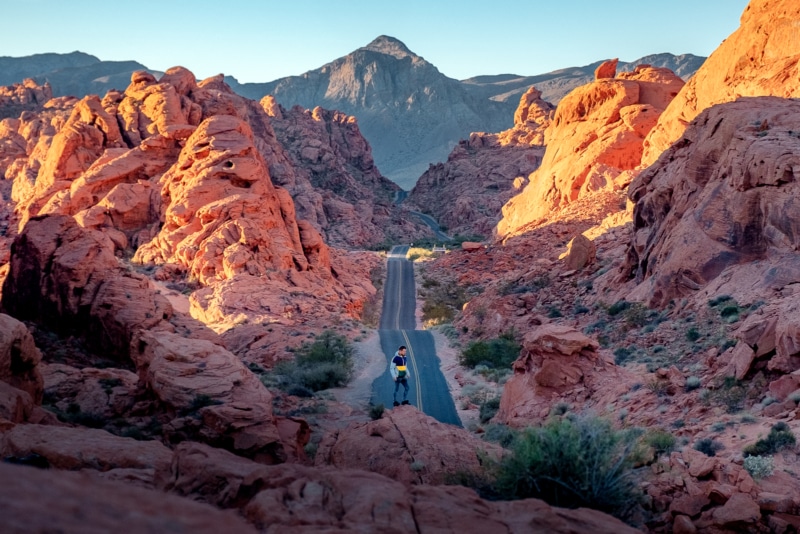
Assuming you got up early for Mt. Charleston and you still have some time left in your trip, head over to the Valley of Fire. Located on the other side of Las Vegas, the valley is only a short two hour from Mt. Charleston, and only one hour from Vegas.
Curious what the Valley of Fire has to offer?
Let’s just say it’s famous for red sandstone formations, picturesque desert landscapes, and a little self-discovery. You can’t go wrong with any of those things.
Whatever you do, make sure you bring a map with you, or have your stops picked out ahead of time—there’s no cell phone service in the park!
Getting From Death Valley to Las Vegas
Beautiful scenery and all, you no doubt are ready to head home after being in the heat for so long. Getting from Death Valley to Las Vegas is really easy. The trip shouldn’t take more than two2 hours unless you stop for lunch.
You have two options for getting back to Vegas depending where you ended your trip.
- Northeast Death Valley: If your trip ended in Rhyolite, the quickest way back is Route 95. That drive will take around 2 hours and is 123 miles in total.
- East Death Valley: If your trip ended anywhere near Badwater Basin or Furnace Creek, you’ll want to take NV-160. The drive totals 2 hours and 110 miles.
- Valley of Fire: If you took the recommended route above and ended in the Valley of Fire, just jump back on I-15 S—the drive is 50 miles and should only take an hour.
Once back in Las Vegas, take a load off at the Red Rock Casino, Resort and Spa. It’s located at the western edge of the city. The resort sits right next to the Red Rock Canyon National Conservation Area, giving you a chance to explore the desert a little bit more before you end your trip.
Or, if you’d rather hit the strip, you’re just a quick 20 minute drive away!
Where to Stay in Death Valley
If you’re planning a multi-day trip to Death Valley, you’re obviously going to need a place to sleep. You have a few options, depending on the length of your stay, the type of trip you want to have and, most importantly, your budget.
Campgrounds
Camping in Death Valley is a lot of fun (and really cheap!) but it can also be challenging if you’ve never gone camping before. The Furnace Creek, Sunset, and Texas Springs campgrounds offer a mix of traditional camping and glamping, while Stovepipe Wells is situated in a town that features amenities, a hotel with a pool, and more.
- Furnace Creek
- Sunset at Furnace Creek
- Texas Springs at Furnace Creek
- Stovepipe Wells
Click here for more information on camping in Death Valley.
Hotels in Death Valley
Maybe camping isn’t your thing. There’s nothing wrong with that, either—Death Valley has several hotels just for you.
The Stovepipe Wells Village has an air conditioned hotel with a pool, as well as many other attractions. Furnace Creek has The Inn and The Ranch, both of which have a distinct style. The inn is a more traditional hotel experience, complete with a breathtaking view, while the ranch is thematic and is great for families.
Hotels Outside the Park
If you’re looking for something outside of Death Valley, check out the Atomic Inn in Beatty, which is stylized like the classic American motels.
Alternatively, opt for the aptly-named Death Valley Inn.
You may also want to check out Wine Ridge in Pahrump. This may come as a surprise, but Wine Ridge serves wine. And you know what? There’s no better way to relax after a long day.
Take Your Time—Death Valley Is Worth It
I’ve traveled to many places in my life. But I can honestly say I love the uniqueness of Death Valley. Whether it’s the distinct earthy tones, the sense of openness, or the abandoned towns, I found myself enjoying everything it had to offer.
The next time you’re in Nevada, you should add Death Valley to your itinerary. And if you’re not planning to be in Nevada anytime soon, well, maybe you should!
The stark beauty of the desert is something you have to see with your own eyes. Instead of trying to rush through Death Valley in a single day trip from Las Vegas, turn it into a multi-day road trip.
Take your time in Death Valley. You only get one chance to experience it for the first time, so why not make it a memorable experience?
READ MORE:
Death Valley Road Trip FAQs
-
What is the most scenic drive through Death Valley?
Artists’ Drive is my favorite scenic drive through Death Valley.
-
Is it worth it to drive through Death Valley?
A drive through Death Valley is definitely worth it.
-
How many days are enough in Death Valley?
I took 3 days to drive through Death Valley, and I think that’s a good amount of time to spend in the park.
-
Do you need 4 wheel drive in Death Valley?
You don’t need a 4 wheel drive for most of Death Valley. There are a few more remote roads that require it, though.
-
Is it safe to drive in Death Valley at night?
Death Valley is safe to drive at night, and the dark skies are spectacular. Just be sure not to doze off.
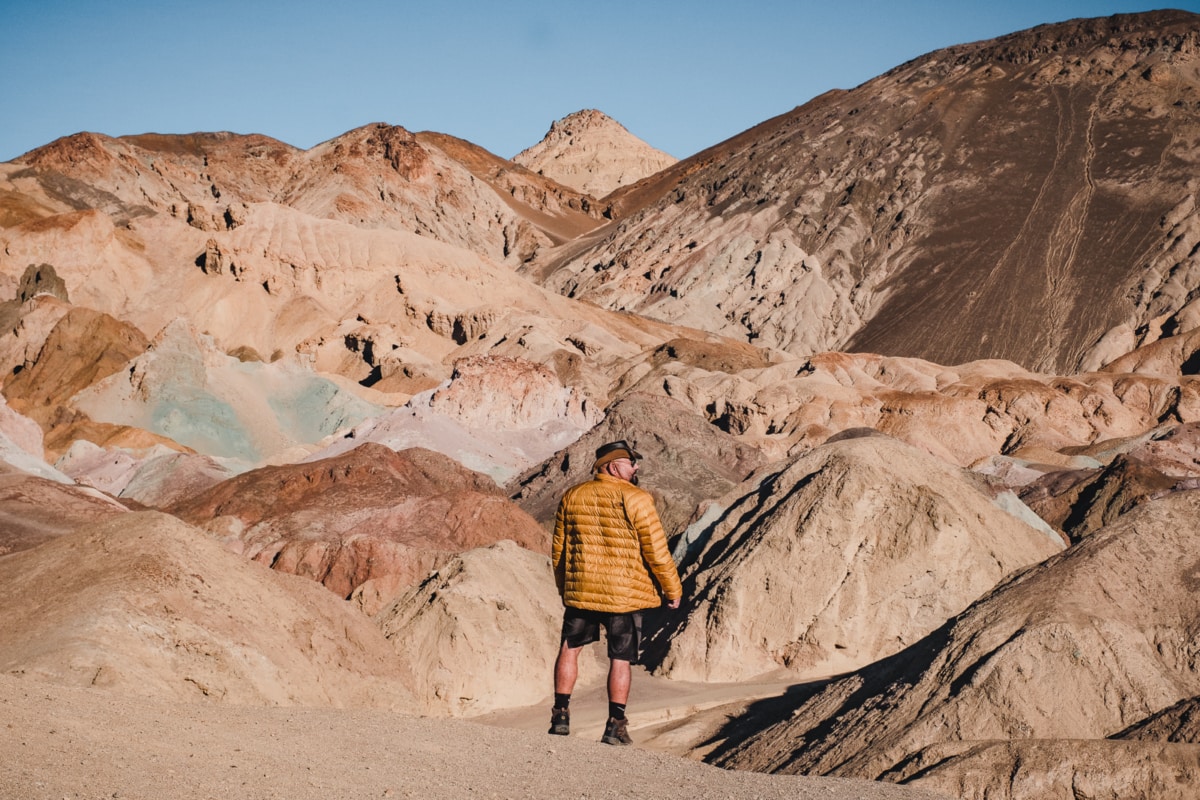

Hi Jeremy, this is really a nice place to visit. Can you suggest a group tour that I can join to Death Valley?